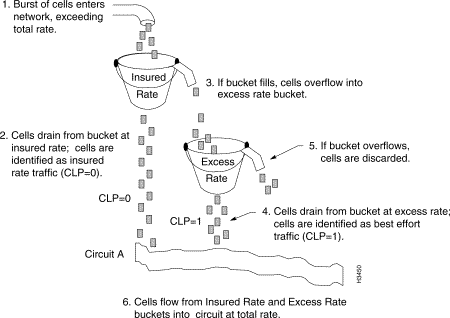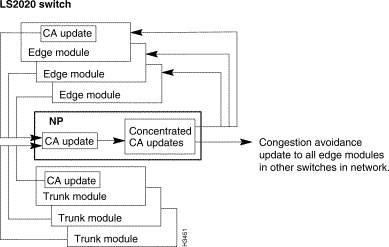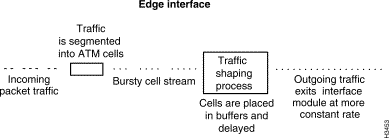|
|

The LightStream 2020 multiservice ATM switch (LS2020 switch) traffic management facility, called ControlStream, allows network administrators to maximize available network resources. ControlStream provides control over network resource allocation and ensures efficient use of resources that have not been explicitly allocated. This traffic management facility controls two key aspects of the quality of service (QoS) on every VCC:
The first section of this chapter discusses delay, which is controlled by a mechanism called transmit priority. Delay-sensitive traffic can be given preferential treatment in an LS2020 network if you assign it a higher transmit priority.
The remainder of this chapter discusses support for bandwidth availability. Bandwidth availability is controlled by four complementary mechanisms that operate at different levels in the network:
The bandwidth availability mechanisms are supported by two additional traffic management features:
Delay-sensitive traffic (SNA traffic, for example) must get through the network quickly. By setting the transmit priority attribute (also known as forwarding priority or transfer priority), an LS2020 network administrator can control the amount of delay experienced by traffic on a VCC.
When more than one cell or packet is waiting to be forwarded through a switch, trunk, or edge port, cells or packets on VCCs with a higher transmit priority are always forwarded before cells or packets on VCCs with a lower transmit priority. As a result, traffic on higher priority VCCs experiences consistently less delay than traffic on lower priority VCCs traversing the same path.
Three transmit priority levels are intended for user data traffic. A fourth (higher) priority level is assigned to internal control traffic (such as VCC setup messages and congestion avoidance updates), and a fifth (highest) priority level is assigned to user CBR traffic. These two additional priority levels ensure that the network remains responsive under all traffic conditions. For details on setting the transmit priority attribute, see the LightStream 2020 Configuration Guide.
To make efficient use of network resources, an LS2020 network keeps track of the bandwidth available at each of its trunk and edge ports. There are two types of bandwidth in an LS2020 network:
You use allocated bandwidth for traffic that must be passed through the network under all circumstances. This bandwidth is explicitly reserved along the path of a VCC.
Best effort bandwidth is the bandwidth available on a trunk or edge port after the allocated bandwidth needs have been served. You use best effort bandwidth for traffic that can be dropped during network congestion.
Figure 4-1 shows the relationship between allocated and best effort bandwidth on a trunk or an edge port.

The allocated bandwidth is the total amount of bandwidth that has been reserved by VCCs passing through the port. Allocated bandwidth rises and falls as VCCs are added, removed, or modified. The amount of best effort bandwidth is a combination of the following:
Availability of unallocated bandwidth is tracked by the global information distribution (GID) system described in the chapter entitled "Network Connections." Availability of best effort bandwidth is tracked by the rate-based congestion avoidance system, which is discussed later in this chapter.
The call admission control mechanism determines whether the network can support a requested VCC. It looks to see if a path exists between the two designated endpoints for the VCC and determines if there is enough bandwidth along the path to support the new VCC.
When a new VCC is created, its bandwidth requirements are determined by configuration parameters set by the network administrator. Two of these parameters are used by the call admission control mechanism:
The network rejects a VCC if no path exists with the capacity to accept the full insured rate. However, the network permits a VCC to be built through the use of trunk or edge ports that do not have the capacity to accept the full maximum rate.
The LS2020 network reserves 100 percent of the Insured Rate for each connection it accepts. As a result, insured traffic is never dropped when congestion occurs. The network reserves only a fraction of the difference between the maximum rate and the insured rate. This ensures that consumers of best effort bandwidth are distributed evenly across available trunks. When it reserves bandwidth for a packet interface, the network adjusts the reservation size upward to account for fragmentation that occurs when variable-length packets are segmented into fixed-length cells.
The reservations are implemented through in increase in the allocated bandwidth on each trunk and edge port traversed by the VCC. When a VCC is removed from the network, the bandwidth reserved for it is freed by a reduction in the allocated bandwidth on each trunk and edge port traversed by the VCC.
Traffic policing in an LS2020 network is done at the edges of the network for both frame-based and cell-based traffic. The traffic policing mechanism decides whether to accept a unit of incoming traffic (packet or cell), and whether it is to be carried using allocated or best effort bandwidth.
Every VCC in an LS2020 network is controlled by a traffic policer at the input edge port. The operation of the policer is governed by the insured and maximum rates discussed in the previous section, plus two additional parameters, total tate and excess rate (see Figure 4-2).

The total rate is the aggregate bandwidth that the LS2020 network is currently accepting for an individual VCC. This rate varies over time depending on the information received from the rate-based congestion avoidance system. The total rate is never lower than the insured rate, and it is never higher than the maximum rate. The excess rate is the difference between the total rate and the insured rate.
The operation of the policer is also influenced by two parameters not shown in Figure 4-2, called insured burst and maximum burst. These items are per-VCC configuration parameters set by the network administrator. They determine how much traffic can be buffered instantaneously for an individual VCC.
As traffic arrives for transmission on a VCC, the LS2020 network uses the total rate and maximum burst parameters to determine which traffic, if any, should be dropped before it even enters the network. The insured rate and insured burst parameters are used to distinguish between insured traffic (using allocated bandwidth) and best effort traffic (using best effort bandwidth). Best effort traffic can be dropped within the network should congestion occur.
LS2020 traffic policers use the leaky bucket algorithm required by the ATM Forum UNI specification. The leaky bucket algorithm behaves like a bucket with a hole in its bottom. If data flows into the bucket faster than it flows out, the bucket eventually "overflows," causing data to be discarded until there is enough room again for new data to be accepted.
The leaky bucket algorithm uses two parameters to control traffic flow:
The leaky bucket algorithm also uses two state variables:
The leaky bucket algorithm operates on each incoming cell as indicated in the following formula:
virtual time = max (virtual time, current time)
if (virtual time + 1/average rate > current time + burst)
drop the incoming cell
else
put the cell in the bucket
virtual time = virtual time + 1/average rate
If, for example, the average rate is 10 cells per second, and the burst is 50 cells, the virtual time and current time remain the same as long as the input rate remains at or below 10 cells per second. If an instantaneous burst of 25 cells is received, the virtual time moves ahead of the current time by 2.5 seconds. If this is followed immediately by a second burst of 30 cells, the virtual time moves ahead of the current time by 5 seconds, and the last 5 of the 30 cells are dropped.
For packet traffic, the unit of incoming data is larger than a single cell. For packet interfaces, the leaky bucket algorithm takes the packet size into account, as shown in the following formula:
virtual time = max (virtual time, current time)
if (virtual time + (packet size / average rate) > current time + burst)
drop the incoming packet
else
segment the packet into cells
put the cells in the bucket
virtual time = virtual time + (packet size/average rate)
In this version of the algorithm, packet size is the number of cells required to transport the packet across the network, including the overhead imposed by the ATM adaptation layer.
The algorithm drops the entire packet if it does not fit into the space available in the leaky bucket. Therefore, it is important to make sure the burst size on a packet interface is large enough to accommodate at least one or two maximum-size packets.
The arrangement of the leaky buckets in an LS2020 traffic policer is shown in Figure 4-3.

The insured rate bucket in Figure 4-3 determines whether an incoming unit of data (packet or cell) can be accommodated by the insured bandwidth for this VCC. The parameters for this leaky bucket are the insured rate and the insured burst for the VCC. If the test succeeds, the unit of data is segmented into cells (if it is a packet) and prepared for transmission into the LS2020 switch.
The excess rate bucket determines whether enough best effort bandwidth is available to accommodate the incoming unit of data. The parameters for this leaky bucket are the excess rate and maximum burst for the VCC. If the test succeeds, the unit of data is segmented into cells (if it is a packet) and prepared for transmission into the LS2020 switch.
All traffic entering the network through the excess rate bucket is tagged by having its cell loss priority (CLP) bit in the cell header set to "1." This allows the selective cell discard mechanism to distinguish between traffic that is using best effort bandwidth and traffic that is using allocated bandwidth.
The following examples illustrate how LS2020 traffic policers operate in typical operating scenarios.
Most of the time, traffic policers admit only as much traffic as the network can accommodate. Occasionally, traffic surges may occur at several different sources simultaneously, and they overload trunk or output ports to the point that cells must be discarded. When this occurs, cells are selected for discard according to the drop eligibilities that have been assigned to them at the edge of the network.
A cell can be assigned one of three levels of drop eligibility (see Table 4-1). Because insured cells use allocated bandwidth, they are never selected for discard when congestion occurs. Best effort and best effort plus cells consume unused bandwidth and, therefore, can be dropped. The two levels of best effort drop eligibility are assigned on a per-VCC basis through the setting of a configuration parameter.
The LS2020 rate-based congestion avoidance system monitors resource utilization within the network and periodically updates traffic policers to admit only as much best effort traffic as the network can transport.
This system provides real-time control for preventing congestion and for reacting to congestion if it occurs. Network congestion occurs when the offered load exceeds the capacity of a network resource. The results of congestion are increased delay and reduced throughput. Because the LS2020 network does not permit over-allocation of insured bandwidth, insured traffic is never affected by congestion. Therefore, the LS2020 rate-based congestion avoidance algorithm regulates best effort and best effort plus traffic only.
Congestion occurs principally because the allocation of resources for best effort traffic relies on its statistical nature. Since it is highly unlikely that every traffic source will generate a traffic burst at the same time, networks are generally designed with less internal capacity than the total input and output capacity of attached hosts. This is the economic advantage of a network over a collection of dedicated lines.
When short bursts of traffic occur that exceed the capacity of a network resource, the selective cell discard mechanism drops best effort traffic inside the network. However, this solution works only for short-lived congestion problems. If the offered traffic continues to exceed the capacity of a network resource, it is more efficient to drop traffic at the edge of the network, since this allows more bandwidth to be used by traffic that will reach its destination.
The LS2020 network's rate-based congestion-avoidance feedback mechanism operates as a continuous loop (see Figure 4-4). Trunk and edge modules periodically generate congestion avoidance updates and pass the updates to associated NPs. Each NP then concentrates this information into a larger update and sends it out to every edge module in the network.

The traffic policer for every VCC is continually updated and admits only as much best effort traffic as the network has the capacity to handle. When a surge of traffic impacts a trunk or output port, all the VCCs traversing the port are quickly throttled. When the surge abates, all the VCCs are allowed to send at higher rates.
Figure 4-5 shows the effect that the rate-based congestion avoidance system has on the traffic policers for a VCC that is carrying both best effort and insured traffic.

Three important characteristics of a rate-based congestion system are:
Traffic shaping minimizes the occurrence of large bursts of traffic on the network. You can shape traffice by segmenting it, placing it into buffers, and delaying its entry into the network, thereby ensuring a more constant flow of traffic in the network.
In an LS2020 network, traffic shaping is performed at all packet interfaces (see the incoming packet traffic in Figure 4-6). Traffic entering ATM UNI interfaces, however, does not need to be shaped, because it obeys the traffic-policing parameters set for each virtual circuit.

|
|